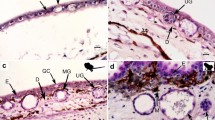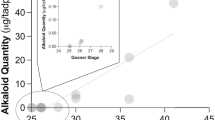Abstract
Parents in many taxa, including insects, molluscs, fish, snakes, and amphibians provision chemical defences, such as peptides, steroids, or alkaloids to their offspring to reduce the risk of predation. In most cases, those defences are transferred to offspring in the egg and gradually diminish throughout the larval period. Adult poison frogs sequester alkaloid-based defences from arthropod prey in granular skin glands. In at least one poison frog, Oophaga pumilio, mother frogs intermittently feed tadpoles until metamorphosis with nutritive eggs containing those alkaloid-based defences. However, alkaloids are not detected in tadpoles until they reach the middle stages of larval development. Here, we investigate the histology of a developmental series of O. pumilio tadpoles to determine whether their ontogenetic alkaloid profile coincides with granular gland development. Our findings suggest that alkaloid sequestration in tadpoles is delineated by the differentiation of rudimentary granular skin glands in epithelial tissue. The timing of differentiation of granular glands in this species coincides with other anurans. Thus, provisioning of chemical defences to offspring is likely constrained by developmental timing of derived structures that can effectively store those toxic or noxious compounds.




Similar content being viewed by others
References
Angel R, Delfino G, Parra GJ (2003) Ultrastructural patterns of secretory activity in poison cutaneous glands of larval and juvenile Dendrobates auratus (Amphibia, Anura). Toxicon 41:29–39
Arnold SJ, Wassersug RJ (1978) Differential predation on metamorphic anurans of garter snakes (Thamnophis): social behavior as a possible defense. Ecology 59:1014–1022
Bovbjerg AM (1963) Development of the glands of the dermal plicae in Rana pipiens. J Morphol 113:231–243
Brust DG (1993) Maternal brood care by Dendrobates pumilio: A frog that feeds its young. J Herpetol 27:96–98
Chammas SM, Carneiro SM, Ferro RS, Antoniazzi MM, Jared C (2015) Development of integument and cutaneous glands in larval, juvenile and adult toads (Rhinella granulosa): a morphological and morphometric study. Acta Zool 96:460–477
Daly JW, Myers CW, Whittaker N (1987) Further classification of skin alkaloids from Neotropical poison frogs (Dendrobatidae), with a general survey of toxic/noxious substances in the Amphibia. Toxicon 25:1023–1095
de Sousa VTT, Nomura F, Venesky MD, Rossa-Feres DDC, Pezzuti TL, Andrade GV, Wassersug RJ (2014) Flexible feeding kinematics of a tropical carnivorous anuran tadpole. J Zool 293:204–210
Delfino G, Brizzi R, Alvarez BB, Kracke-Berndorff R (1998) Serous cutaneous glands in Phyllomedusa hypochondrialis (Anura, Hylidae): Secretory patterns during ontogenesis. Tissue Cell 30:30–40
Delfino G, Giachi F, Nosi D, Malentacchi C (2010) Serous cutaneous glands in Phyllobates bicolor (Anura: Dendrobatidae): An ontogenetic, ultrastructural study on secretory product biosynthesis and maturation. Copeia 2010:27–37
Dussourd DE, Ubik K, Harvis C, Resch J, Meinwald J, Eisner T (1988) Biparental defense endowment of eggs with acquired plant alkaloids in the moth Utethesia ornatrix. PNAS 85:5992–5996
Formanowicz DR, Brodie ED (1982) Relative palatabilities of members of a larval amphibian community. Copeia 1982:91–97
Gosner KL (1960) A simplified table for staging anuran embryos and larvae with notes on identification. Herpetologica 16:183–190
Grant T, Frost DR, Caldwell JP, Gagliardo RON, Haddad CF, Kok PJ, Means DB, Noonan BP, Schargel WE, Wheeler WC (2006) Phylogenetic systematics of dart-poison frogs and their relatives (Amphibia: Athesphatanura: Dendrobatidae). Bull Am Mus Nat Hist 299:1–262
Gunzburger MS, Travis J (2005) Critical literature review of the evidence for unpalatability of amphibian eggs and larvae. J Herpetol 39:547–571
Hanifin CT, Brodie ED III, Brodie ED Jr (2003) Tetrodotoxin levels in eggs of the rough-skin newt, Taricha granulosa, are correlated with female toxicity. J Chem Ecol 29:1729–1739
Hutchinson DA, Savitzky AH, Mori A, Meinwald J, Schroeder FC (2008) Maternal provisioning of sequestered defensive steroids by the Asian snake Rhabdophis tigrinus. Chemoecol 18:181–190
Itoi S et al (2013) Larval pufferfish protected by maternal tetrodotoxin. Toxicon 78:35–40
McDiarmid RW, Altig R (1999) Tadpoles: The biology of anuran larvae. University of Chicago Press, Chicago
Mina AE, Ponti AK, Woodcraft NL, Johnson EE, Saporito RA (2015) Variation in alkaloid-based microbial defenses of the dendrobatid poison frog Oophaga pumilio. Chemoecology 25:169–178
Myers C, Daly J, Martinez V (1984) An arboreal poison frog (Dendrobates) from Western Panama. Am Mus Novit 2783:1–20
Neuwirth M, Daly JW, Myers CW, Tice LW (1979) Morphology of the granular secretory glands in skin of poison-dart frogs (Dendrobatidae). Tissue Cell 11:755–771
Nieuwkoop PD, Faber J (1956) Normal table of Xenopus laevis. North Holland, Amsterdam
Reilly DS, Tomassini N, Zasloff M (1994) Expression of magainin antimicrobial peptide genes in the developing granular glands of Xenopus skin and induction by thyroid hormone. Devel Biol 162:123–133
Santos JC, Tarvin RD, O’Connell LA (2016) A review of chemical defense in poison frogs (Dendrobatidae): ecology, pharmacokinetics, and autoresistance. Chem Sign Vertebr 13:305–337
Saporito RA, Isola M, Maccachero VC, Condon K, Donnelly MA (2010) Ontogenetic scaling of poison glands in a dendrobatid poison frog. J Zool 282:238–245
Saporito RA, Donnelly MA, Spande TF, Garraffo HM (2012) A review of chemical ecology in poison frogs. Chemoecol 22:159–168
Stynoski JL (2009) Discrimination of offspring by indirect recognition in an egg-feeding dendrobatid frog, Oophaga pumilio. Anim Behav 78(6):1351–1356
Stynoski JL, Torres-Mendoza Y, Sasa-Marin M, Saporito RA (2014a) Evidence of maternal provisioning of alkaloid-based chemical defenses in the strawberry poison frog Oophaga pumilio. Ecology 95:587–593
Stynoski JL, Shelton G, Stynoski P (2014b) Maternally derived chemical defences are an effective deterrent against some predators of poison frog tadpoles (Oophaga pumilio). Biol Lett 10:20140187
Taylor AC, Kollros JJ (1946) Stages in the normal development of Rana pipiens larvae. Anat Rec 94:7–23
Terreni A, Nosi D, Greven H, Delfino G (2003) Development of serous cutaneous glands in Scinax nasica (Anura, Hylidae): patterns of poison biosynthesis and maturation in comparison with larval glands in specimens of other families. Tissue Cell 35:274–287
Toledo RC, Jared C (1995) Cutaneous granular glands and amphibian venoms. Comp Biochem Physiol 111:1–29
Wassersug RJ, Sperry DG (1977) The relationship of locomotion to differential predation on Pseudacris triseriata (Anura: Hylidae). Ecology 58:830–839
Williams BL, Hanifin CT, Brodie ED, Caldwell RL (2011) Ontogeny of tetrodotoxin levels in blue-ringed octopuses: Maternal investment and apparent independent production in offspring of Hapalochlaena lunulata. J Chem Ecol 37:10–17
Acknowledgements
The authors thank Kim Hoke for equipment use and Alexandre-Benoit Roland for animal care. JLS is supported by an American Association for University Women American Postdoctoral Fellowship, and LAO is supported by a Bauer Fellowship from Harvard University, the L’Oreal Women in Science Fellowship, the William F. Milton fund from Harvard Medical School, a Konishi Research Grant from the International Society for Neuroethology, and the National Science Foundation (IOS-1528866).
Author contribution
JLS processed samples and wrote the manuscript. LAO acquired samples and edited the manuscript. Both designed the study.
Author information
Authors and Affiliations
Corresponding author
Ethics declarations
Conflict of interest
The authors declare that they have no conflict of interest.
Ethical approval
All applicable international, national, and institutional guidelines for the care and use of animals were followed. All procedures performed in studies involving animals were in accordance with the ethical standards of the Institutional Animal Care and Use Committee of Harvard University (Protocol 12-10-01). This article does not contain any studies with human participants performed by any of the authors.
Informed consent
Informed consent was obtained from all individual participants included in the study.
Electronic supplementary material
Below is the link to the electronic supplementary material.
Rights and permissions
About this article
Cite this article
Stynoski, J.L., O’Connell, L.A. Developmental morphology of granular skin glands in pre-metamorphic egg-eating poison frogs. Zoomorphology 136, 219–224 (2017). https://doi.org/10.1007/s00435-017-0344-0
Received:
Revised:
Accepted:
Published:
Issue Date:
DOI: https://doi.org/10.1007/s00435-017-0344-0




